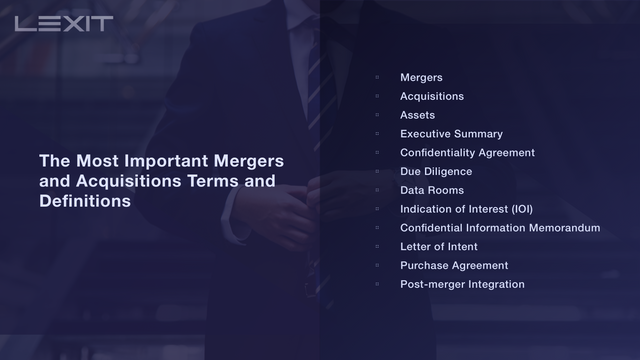12 Basic Definitions You Need To Know About Mergers and Acquisitions
Managing a startup requires a long learning curve. No matter if you are a first-time founder or a seasoned entrepreneur, you should be open to learning at all times during the life cycle of your business or product - especially when the time to exit your project comes closer.
To avoid getting overwhelmed by huge undertaking that is selling a business, it is helpful to learn M&A terms beforehand. By understanding the language of mergers and acquisitions, you can feel confident while buying or selling company assets. Founders are the brain and soul of every project in the marketplace. Therefore, using the appropriate M&A terms is a key aspect of being a responsible business owner.
It is not necessary to be an M&A lawyer or investment expert to comprehend the basics of this industry. Below you can find some key terms and definitions that will be useful to navigate your way through a merger or acquisition process.
Mergers and Acquisition Basic Terms and Definitions

What are Mergers?
Mergers occur when two businesses combine intro a single one. There are two types of mergers: horizontal and vertical. Mergers create value by combining assets and creating consolidated teams that can manage and operate them more efficiently than before.
Mergers can be categorized into five main types:
• Horizontal mergers - which happens between two direct competitors.
• Vertical mergers - which happens between two participants of a single supply chain.
• Market-extension mergers - which happens between similar companies serving different markets.
• Product-extension mergers - which happens between companies that sell related products.
• Conglomerate merger - which happens between unrelated businesses.
A merger can happen in two ways:
• Merger through absorption: is the combination of two or more entities in which only one of them survives while the others cease operations and assume the identity of the surviving company.
• Merger through consolidation: is the fusion of two companies which creates a new entity. The parent companies cease to exist, and a new company begins operations.
What are Acquisitions?
An acquisition happens when a company buys another business or parts of it. Usually a larger entity is the purchaser, while a smaller entity is the one acquired. The buyer earns the control of the purchased company, therefore gaining the power to manage its assets.
Acquisitions also entail the transfer of all the liabilities and market risks of the purchased business. Buyers, however, may negotiate to buy only the assets the purchasing company wants and leave out the one it does not need. 50% of all acquisition deals fail.
Some of the reasons behind business acquisitions are:
• Economy of scale: includes cost-reduction regarding operations, production operations, and increase of profit margins.
• Economy of scope: may be the increase or decrease of the marketing, distribution, or product creations.
• Increase market share: allows the Buyer to cover a bigger share of the targeted market.
• Cross-selling products.
• Synergy: the activation of opportunities in which a business may find unexpected value.
• Taxation motives.
• Diversification opportunities.
• Transfer of resources.
• Vertical integration.
• Hiring key talent.
• Absorb competitors.
• Access a company asset portfolio: including real estate and IP.
• Knowledge acquisition.
What is an Asset?
An asset, in business terms, are items of value which can be owned, created, or employed by a company. Assets can be tangible and intangible and some examples include cash, raw materials, brand reputation, public goodwill, real estate, and intellectual property.
Assets can be categorized according to different factors:
• Current assets - which can be easily converted into cash and have a short life.
• Fixed assets - which are less easily converted into cash and are for long-term use.
• Tangible assets - Physical, material, and financial items of value.
• Fixed assets - Resources that do not have material substance but add value to a company.
Assets can be used to produce value. The property of an asset may be transferable or sold and are a key factor in the balance sheet of a company. In order to achieve a good cash flow and create value, a company should own a mix of current, tangible and intangible assets.
What is an Executive Summary?
The executive summary is an overview of the offering document of an M&A transaction. An executive summary should include a thesis, the Seller intention for participating, and an outline of the transaction the Seller is seeking.
The thesis of an executive summary is the value proposition of the offered deal. It often outlines how the buyer can benefit from the transaction.
The content of an executive summary includes:
• Introduction
• Company overview
○ Background
○ Customer Profile
○ Current clients
• Market
○ Description of the opportunity
○ Competition analysis
○ Current sales and marketing indicators
○ Sales pipeline status
• Products
○ Description
○ Pricing
○ Technical specifications
○ Product development timeline
• Summary
An executive summary should be brief, clear, and catch the eye of the potential Buyer. Its ultimate goal is to sell the company by outlining how it can benefit the Buyer.
What is a Confidentiality Agreement?
Also known as non-disclosure agreement (NDA), this legal document is an agreement between two or more entities that will share information with each other without divulging it with third parties. A Confidentiality Agreement carries legal and ethical obligations to the parties who sign it.
An NDA contains key aspects including:
• The concept of confidentiality.
• Exempted materials, including public information and general data.
• Use of exchanged information, data, and materials.
• Terms of disclosure.
• Coverage of the agreement.
• Chain of command.
• Period of enforcement.
• Terms for the destruction of shared materials.
What is Due Diligence?
Due diligence in M&A is the research of a business which is expected to participate in a merger or an acquisition. Although it can be a legal obligation, most of the times it is a voluntary process. The goal of due diligence is to ease decision-making by improving the amount and quality of business data available to the parties involved and guaranteeing that this information is available in order to make decisions considering all the risks, costs, and potential benefits.
Due diligence often examines:
• Material future matters of a company.
• Current processes and policies of business.
• Company valuation.
• Shareholder analysis.
• The process, structure, timeline, and budget of a merger or an acquisition.
A due diligence process can include nine different areas: business compatibility, financial audit, macro-environment factors, legal and environmental factors, marketing audit, production processes, management evaluation, tech and information systems analysis, and reconciliation audit.
This process impacts the price, representation, transaction agreement warranties, and potential indemnification value of a merger or acquisition deal.
What are Data Rooms?
Data rooms are online and physical places where the key documents of a company are stored, in order to ease a due diligence process and complete an M&A transaction. Some of the documents that can be stored are IP information, employee, product, and client information, accounting statements, and contracts.
Online data rooms also give companies the power to manage their important data and preserve confidentiality through the deal-making process. Some virtual data rooms also provide user access management and information access logs.
During a merger or an acquisition, the data room is usually accessed by Buyers, Sellers, and Service Providers involved in the transaction. With increasing confidentiality issues, online data rooms are preferred over physical ones and rely on complex systems and cloud solutions to guarantee data security.
What is an Indication of Interest (IOI)?
An Indication of Interest is a non-binding document submitted by the Buyer during an acquisition or merger process. An IOI should include an approximate valuation of the target company and the general requirements to complete the transaction.
An Indication of Interest may include the Buyer price range, transaction financing options, required due diligence items and timeline, post-transaction plan, and a timeline for the business transaction.
An IOI is not the same as a LOI (Letter of Intent), as this second one is a more formal way to present the offer from the Buyer and contains more specifications.
What is a Confidential Information Memorandum?
Also known as CIM, this is a document that discloses the products and services, finance information and market date of a Seller. It can be shortened into an Executive Summary, which is then presented to potential Buyers.
A Confidential Information Memorandum includes:
• Company overview
• Key investments
• Products and services
• Market data
• Sales and marketing information
• Management and team overview
• Current financial statements and projections
• Risk analysis
• Appendices
A CIM is not legally binding, as it is a marketing tool used to sell a company or its assets.
What is a Letter of Intent?
Also known as LOI or LoI, a Letter of Intent is a document that outlines an understanding between two or more entities in which they formalize their intention to pursue the completion of this understanding in a legally binding agreement. The outline may belong to a merger or acquisition transaction, joint venture agreement, real property lease agreement, and other material transactions.
LOI are usually short, written in tabular form and may not be entirely binding. Some LOIs are indeed binding, particularly those regarding non-disclosure, current laws, exclusivity or good faith deals.
The goal of a LOI is to protect the parties involved in a business transaction. A Letter of Intent can be negotiated between the involved entities before it is signed and enforced.
What is a Purchase Agreement?
A Purchase Agreement is a legal document that discloses the terms and condition of a merger or an acquisition. It is mutually binding, and includes clauses regarding the assets purchased, the transaction conditions, warranties, key employees, capital flow, representations, closing terms and miscellaneous provisions.
A Purchase Agreement legally transfers the ownership of an entire company or its assets. It also supersedes all previous agreements and understandings between Buyer and Seller, including both written and oral ones.

Don’t Get Overwhelmed by These M&A Terms and Definitions
If you are an entrepreneur, you may be intimidated by all the basic terms involved in mergers and acquisitions. But do not despair, be patient, and use tools such as the LEXIT platformto ease your way through a business transaction.
By knowing the basic definitions used in the M&A industry and how they are used in dealmaking, you will become a better negotiator while selling your company. In other words, by improving your understanding of mergers and acquisitions, you will become a stronger entrepreneur.